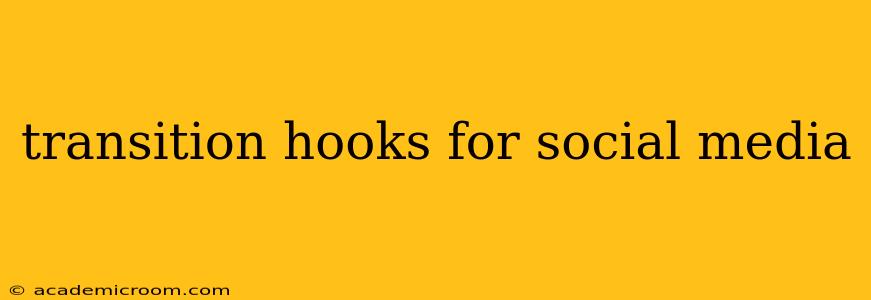Transition Hooks for Social Media: Keeping Your Audience Engaged
Social media thrives on engagement. Keeping your audience hooked requires more than just posting great content; it demands smooth transitions between posts, topics, and even platforms. Effective transition hooks maintain momentum, prevent your feed from feeling disjointed, and encourage further interaction. This guide explores various techniques for creating compelling transition hooks that will elevate your social media game.
What are Transition Hooks and Why are They Important?
Transition hooks are short, attention-grabbing phrases or statements used to connect different pieces of content, either within a single post or across multiple posts. They serve as bridges, linking one idea to the next and maintaining the flow of your narrative. Why are they important? Because they:
- Improve Engagement: They keep your audience invested and encourage them to continue scrolling or clicking.
- Enhance Storytelling: They help you build a cohesive narrative across your social media presence.
- Boost Brand Consistency: They reinforce your brand's voice and personality.
- Increase Reach: A well-crafted transition can lead to increased shares and organic reach.
Types of Transition Hooks for Social Media
There are many ways to craft effective transition hooks. Let's explore some popular types:
1. Question Hooks: These invite audience participation and encourage interaction.
- Example: "Now that we've explored the benefits of X, what are your experiences with it?"
- Effective because: It prompts replies, fostering community and engagement.
2. Cliffhanger Hooks: These leave the audience wanting more, creating anticipation for your next post.
- Example: "But the story doesn't end there... stay tuned for tomorrow's post to find out what happens next!"
- Effective because: It generates excitement and encourages followers to return for more.
3. Teaser Hooks: These offer a glimpse into future content without giving too much away.
- Example: "Got a big announcement coming soon... hint: it involves [topic]! Stay tuned."
- Effective because: It builds anticipation and excitement.
4. Recap Hooks: These briefly summarize previous content before transitioning to a new topic.
- Example: "So we've covered [topic A] and [topic B]. Now let's dive into [topic C]..."
- Effective because: It provides context and helps the audience follow along.
5. Visual Hooks: Images, GIFs, or videos can act as compelling transitions, visually linking related content.
- Example: A short video clip showcasing a before-and-after transformation, transitioning from a problem to a solution.
- Effective because: It uses visual storytelling to engage the audience.
How to Craft Effective Transition Hooks: Tips & Examples
- Know your audience: Tailor your hooks to resonate with their interests and language.
- Keep it concise: Shorter is often better on social media. Aim for brevity and impact.
- Use strong verbs: Words like "discover," "uncover," "explore," and "learn" add energy and intrigue.
- Create a sense of urgency: Phrases like "Don't miss out," "Limited time offer," or "Learn more now" can encourage immediate action.
- Maintain consistency: Develop a consistent style for your hooks to reinforce your brand identity.
Examples across platforms:
- Instagram: Use a carousel post, where each image seamlessly flows into the next with a brief caption transition.
- Twitter: Use threads to connect related tweets, utilizing transitions between each tweet.
- Facebook: Create a series of posts, using transitions to build anticipation and link related topics.
H2: What are some examples of good transition hooks?
Good transition hooks vary depending on the platform and content, but generally, they share qualities of being concise, intriguing, and relevant to the preceding and following content. Here are some examples across different scenarios:
- From a product feature highlight to a customer testimonial: "We've shown you how amazing Feature X is, but don't just take our word for it! Check out what [customer name] has to say..."
- From a blog post summary to a call to action: "So, we've learned about the importance of [topic]. Ready to put this into practice? Click the link in our bio to learn more!"
- From a funny anecdote to a serious point: "That reminds me of a funny story... but on a more serious note, let's discuss..."
- From one day’s post to the next: "Yesterday we talked about [topic], today let's explore [related topic] to delve deeper."
H2: How can I use transition hooks to improve engagement on social media?
Transition hooks directly enhance engagement by creating a more natural and appealing user experience. Instead of jarring jumps between disparate ideas, they build a flow that keeps users reading/watching/listening. This leads to:
- Increased Dwell Time: People spend more time on your page, consuming more content.
- Higher Click-Through Rates: Well-crafted hooks encourage clicks to further content.
- More Comments & Shares: Engaging transitions promote conversation and interaction.
- Stronger Brand Loyalty: Consistent and high-quality storytelling fosters trust and connection.
Remember that the key is consistency. Regularly employing well-crafted transition hooks will significantly improve the overall engagement and impact of your social media strategy.
